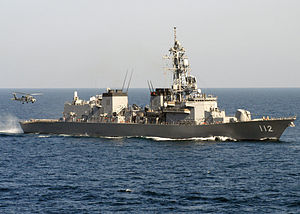Takanami-class destroyer
Destroyer class in the Japanese Maritime Self-Defense Forces From Wikipedia, the free encyclopedia
The Takanami-class destroyer (たかなみ型護衛艦, Takanami-gata-goei-kan) is a class of destroyer serving with the Japan Maritime Self-Defense Force (JMSDF). This warship is the slightly modified class of second-generation, general-purpose destroyers of the JMSDF.[1]
You can help expand this article with text translated from the corresponding article in Japanese. (February 2020) Click [show] for important translation instructions.
|
 JS Makinami | |
| Class overview | |
|---|---|
| Name | Takanami-class destroyer |
| Builders |
|
| Operators | Japan Maritime Self-Defense Force |
| Preceded by | Murasame class |
| Succeeded by | Akizuki class |
| Built | 2000–2004 |
| In commission | 2003–present |
| Completed | 5 |
| Active | 5 |
| General characteristics | |
| Type | General-purpose destroyer |
| Displacement | |
| Length | 151 m (495 ft 5 in) |
| Beam | 17.4 m (57 ft 1 in) |
| Height | 10.9 m (35 ft 9 in) |
| Draft | 5.3 m (17 ft 5 in) |
| Propulsion |
|
| Speed | 30 knots (56 km/h; 35 mph) |
| Complement | 175 |
| Sensors and processing systems |
|
| Electronic warfare & decoys |
|
| Armament |
|
| Aircraft carried | 1 × SH-60J(K) anti-submarine helicopter |
| Aviation facilities | Hangar and helipad |
Background
Since FY1991, the JMSDF started construction of the second-generation, general-purpose destroyers (汎用護衛艦, Hanyou-goei-kan), Murasame class. These destroyers are generally satisfactory for the fleet, but there is some discontent.[1] From FY1998 onwards, a slightly modified version that corrected these dissatisfaction points was to be built: Takanami class.[1]
Design
The hull design is generally based on that of the Murasame class. However, the weapons mounted are different, and as a result, the internal structure has also been changed. The large lattice mast affected the stealthiness of the Murasame class, so in Takanami class, it was planned to change to two small masts, but that was not implemented.[2]
Although their displacement become slightly increased, there was no change to their main engines, as it was not a big difference so it had little effect on the performance of the ship.[2]
Equipment
The combat system was slightly improved. The combat direction system is similar to the Murasame class in the first three ships, but in the fourth ship, workstations were changed to AN/UYQ-70, and in the fifth ship, it corresponded to the communication in Link 16.[3] Radars are the same as those of Murasame class, sonars are also small revision type.[4]
In terms of weaponry, instead of the 3-inch gun that has been adopted by conventional destroyers, a larger Oto Melara 127 mm gun was introduced. Although vertical launching systems were divided into two places in the Murasame class, 16-cell Mk 41 for VL-ASROC on the bow deck and 16-cell Mk 48 for Sea Sparrow (later replaced with Evolved Sea Sparrow) on the middle deck, they are compiled in one place, 32-cell Mk 41 on the bow deck in this class.[4]
Ships in the class
| Pennant no. | Name | Laid down | Launched | Commissioned | Builder | Homeport |
|---|---|---|---|---|---|---|
| DD-110 | Takanami (Tall Waves) | 25 April 2000 | 26 July 2001 | 12 March 2003 | IHI, Uraga, Kanagawa | Yokosuka |
| DD-111 | Ōnami (Large Wave) | 17 May 2000 | 20 September 2001 | 13 March 2003 | Mitsubishi, Nagasaki | Yokosuka |
| DD-112 | Makinami (Rolling Waves) | 17 July 2001 | 8 August 2002 | 18 March 2004 | IHI, Uraga, Kanagawa | Ōminato |
| DD-113 | Sazanami (Ripples on the Water) | 4 April 2002 | 29 August 2003 | 16 February 2005 | Mitsubishi, Nagasaki | Kure |
| DD-114 | Suzunami (Breaking Waves) | 24 September 2003 | 26 August 2004 | 16 February 2006 | IHI, Uraga, Kanagawa | Ōminato |
See also
References
External links
Wikiwand - on
Seamless Wikipedia browsing. On steroids.
